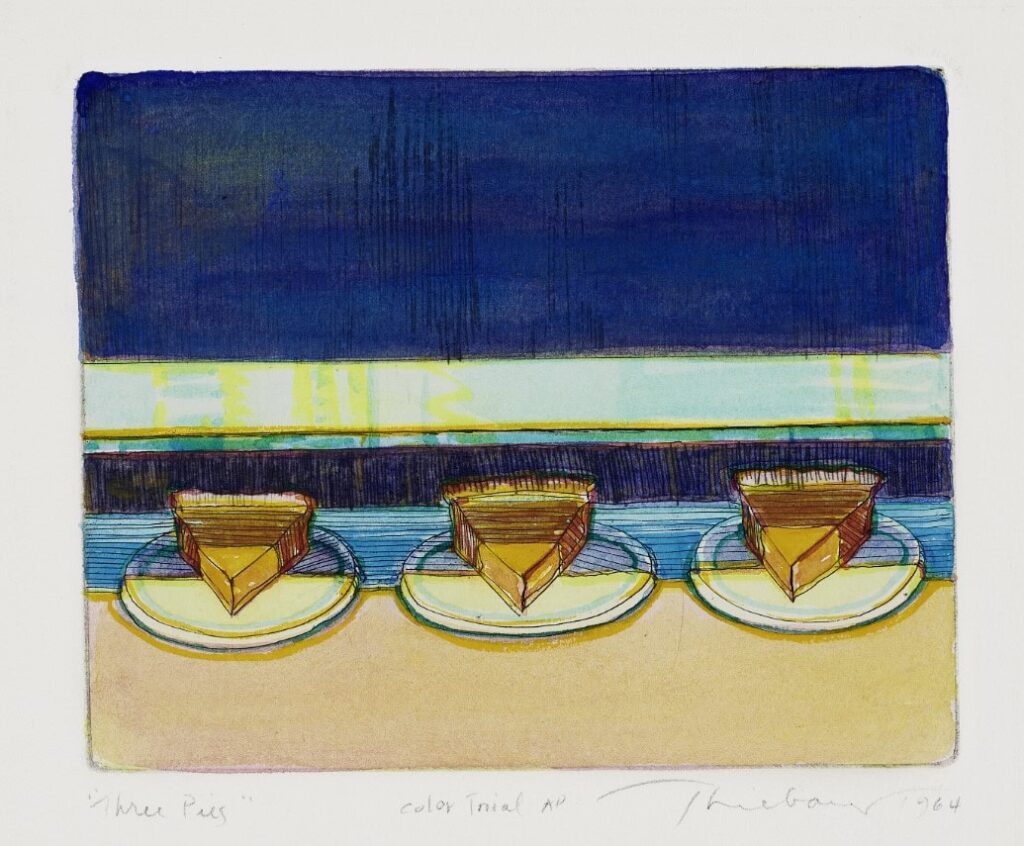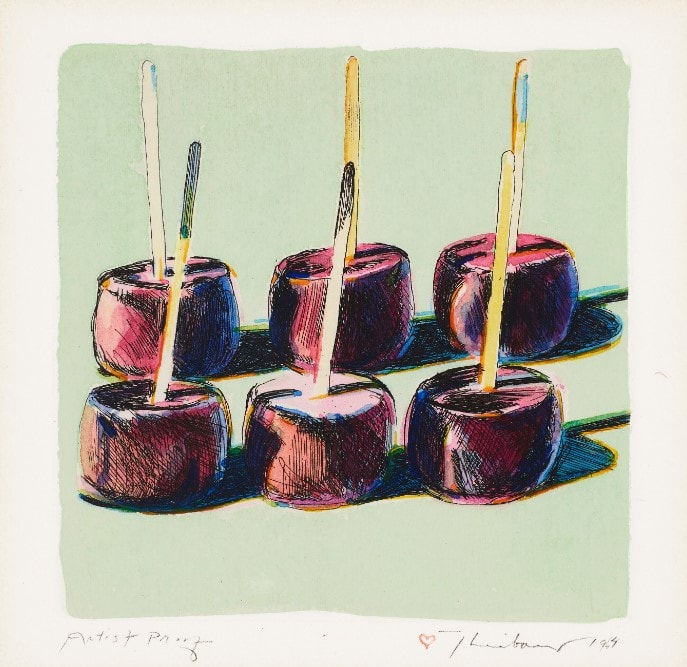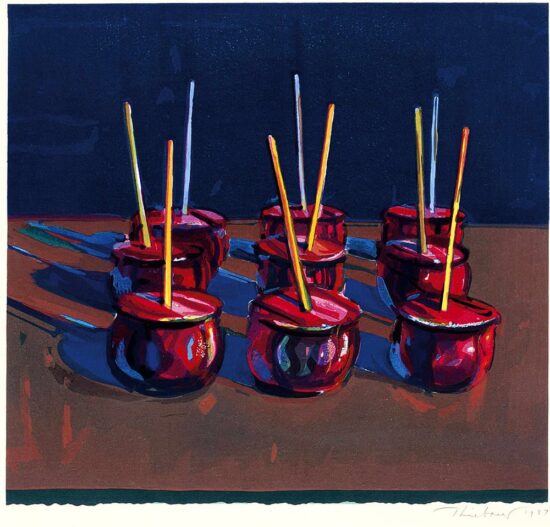Wayne Thiebaud (1920-2021) was an American painter widely recognized for his colorful depictions of everyday objects, particularly desserts and pastries. Though his work also encompasses a broader range of influences and styles, this ordinary subject matter made him a key figure in the Pop Art movement. His career spanned several decades, and he made significant contributions to contemporary art with his distinct blend of realism and vibrant color.
Early Life and Education
Birth and Childhood: Wayne Thiebaud was born on November 15, 1920, in Mesa, Arizona. The next year, his family moved to Long Beach, California, where Thiebaud lived until graduating high school.
Education: Thiebaud's formal art education began at Long Beach Polytechnic High School and continued at the Frank Wiggins Trade School, now known as Los Angeles Trade-Technical College. He attended San Jose State College (now San Jose State University) from 1949-1950 and transferred to Sacramento State College (now California State University, Sacramento), where he earned a bachelor's degree in 1951 and a master's degree in 1952.
Notable Paintings
Thiebaud's paintings, celebrated for his unique style and depictions of everyday objects, have garnered significant acclaim and value in the art market. His works span various subjects, including desserts, landscapes, and figures, each rendered in his distinct, textured style that is both nostalgic and contemporary. As his legacy endures, Thiebaud’s paintings remain cherished for their vibrant colors, playful compositions, and the nostalgic charm they evoke. Here’s an overview of his notable paintings and their significance:
"Cakes" (1963)
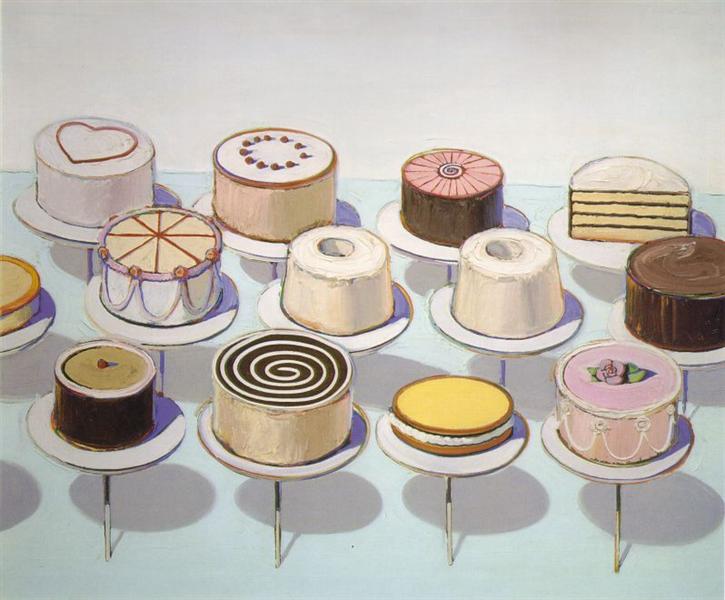
- Description: This iconic painting features an array of cakes displayed in rows, each rendered with thick, luscious brushstrokes that mimic the texture of frosting and pastel colors that suggest the sweetness of these neatly arranged desserts.
- Significance: "Cakes" epitomizes Thiebaud’s ability to transform ordinary subjects into captivating works of art that capture the essence of the feature objects — in this case, a selection of sweet, delectable confections.
"Three Machines" (1963)
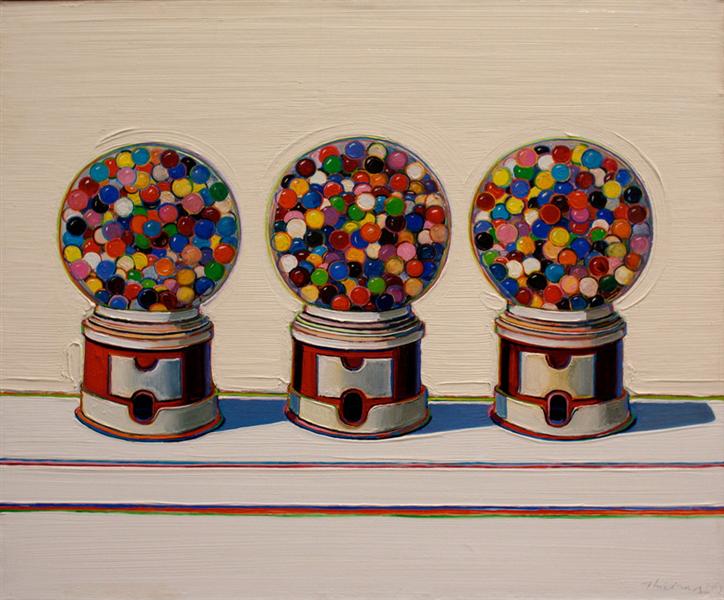
- Description: This work depicts three gumball machines, arranged neatly in a row on a raised platform. Filled to the brim with a rainbow or vibrantly colored gumballs, these gumball machines highlight Thiebaud’s interest in commercial objects and his skill in using color and form to create a sense of nostalgia and whimsy.
- Significance: The painting showcases Thiebaud's attention to detail and his ability to infuse everyday objects with a sense of character and life.
"Pies, Pies, Pies" (1961)
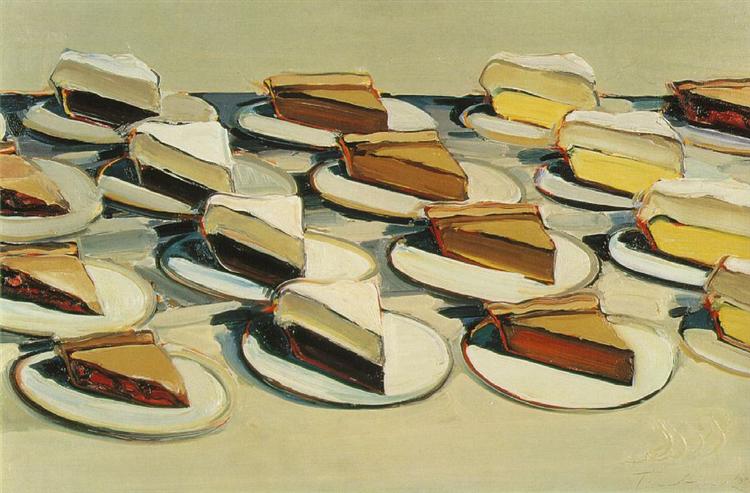
- Description: Pies, Pies, Pies is vivid portrayal of various slices of pies, neatly arranged in diagonal lines across the canvas. This painting is notable for its patterned repetition and strong diagonals, combined with the thick application of richly colored paint that parallels the richness of the dessert.
- Significance: The repetition in this piece, use of colors, and portrayal of desserts exemplifies Thiebaud’s signature style and his fascination with the visual appeal of confections.
"Watermelon Slices" (1961-1962)

- Description: This painting features slices of watermelon on plates, arranged in a triangular shape. The red color of the watermelon stands out against the pastel blue and white of the table and plates and highlights Thiebaud's use of bright colors and his focus on everyday items.
- Significance: The work captures the essence of summer and showcases Thiebaud's playful approach to composition and color.
"San Francisco West Side Ridge" (2001)
- Description: A cityscape painting depicting the steep streets of San Francisco with exaggerated perspectives, bold colors, and strong diagonals shape the landscape and create a dramatic visual effect.
- Significance: This work is part of Thiebaud’s cityscape series that explores urban environments, and it demonstrates his unique and dynamic approach to landscapes.
Common Motifs in Wayne Thiebaud's Works
Wayne Thiebaud's paintings are highly valued and widely recognized in part because of his repeated motifs, such as desserts, cityscapes, and commercial objects. These motifs reflect the artist's fascination with the beauty of everyday objects and his textured, vibrantly colored, and playful yet precise compositions elevate ordinary subjects into extraordinary works of art and make Thiebaud's works instantly recognizable. Here are some motifs most commonly found in Thiebaud's paintings:
Desserts and Pastries Motifs
- Description: Paintings featuring cakes, pies, ice cream cones, and other sweets.
- Significance: These works are renowned for their bright colors, thick impasto, and neat and precise, almost commercial, presentation. They highlight Thiebaud's fascination with the aesthetic appeal and cultural significance of food.
- Examples: "Pies, Pies, Pies" (1961), "Cakes" (1963), "Four Cupcakes" (1971).
Commercial Objects Motifs
- Description: Everyday items such as gumball machines, candy jars, and toys.
- Significance: These paintings reflect Thiebaud's background in commercial art and his interest in the mundane objects of American consumer culture. They often evoke nostalgia and emphasize the formal qualities of the objects through exaggerated perspectives and bold colors.
- Examples: "Three Machines" (1963), "Gumball Machine" (1970), "Mickey Mouse" (1988).
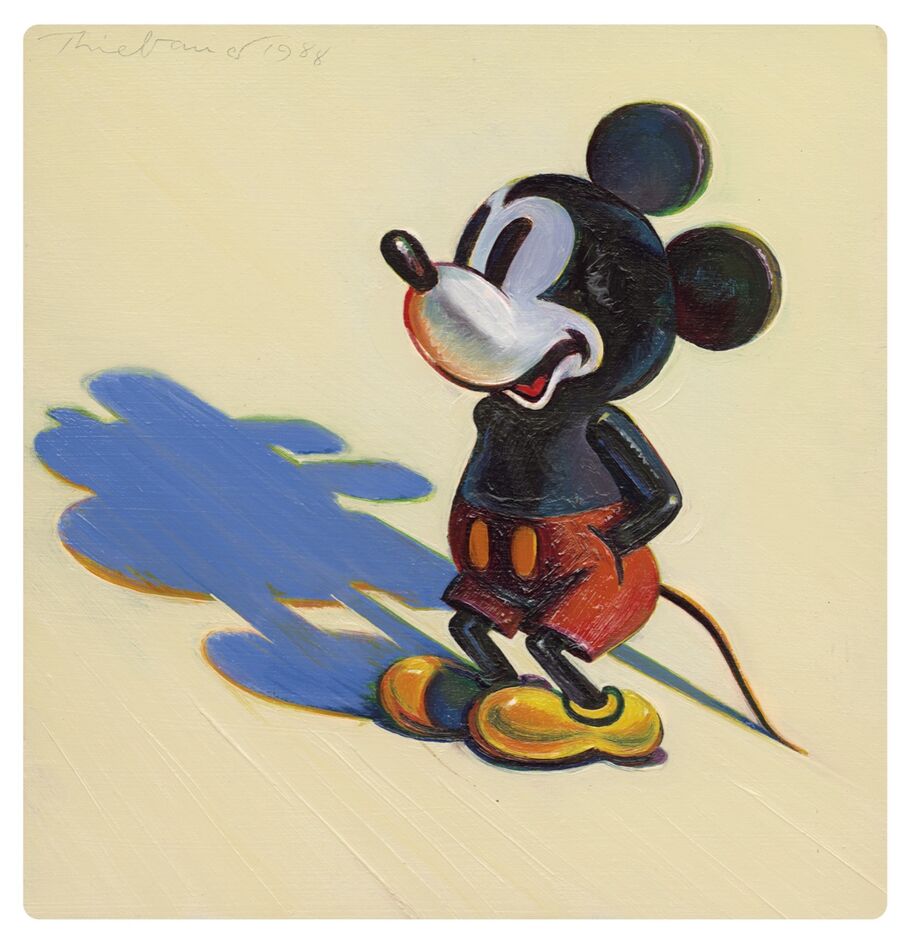
Cityscapes and Landscapes
- Description: Renderings of urban and rural environments, often with exaggerated perspectives and vibrant hues.
- Significance: Thiebaud’s cityscapes and landscapes explore the geometric patterns and structural forms of the environment. His depictions of San Francisco’s steep streets are particularly notable for their dramatic angles and vivid color schemes.
- Examples: "San Francisco West Side Ridge" (2001), "River and Farms" (1996), "Flatland River" (1997), "Hill Street" (1987).
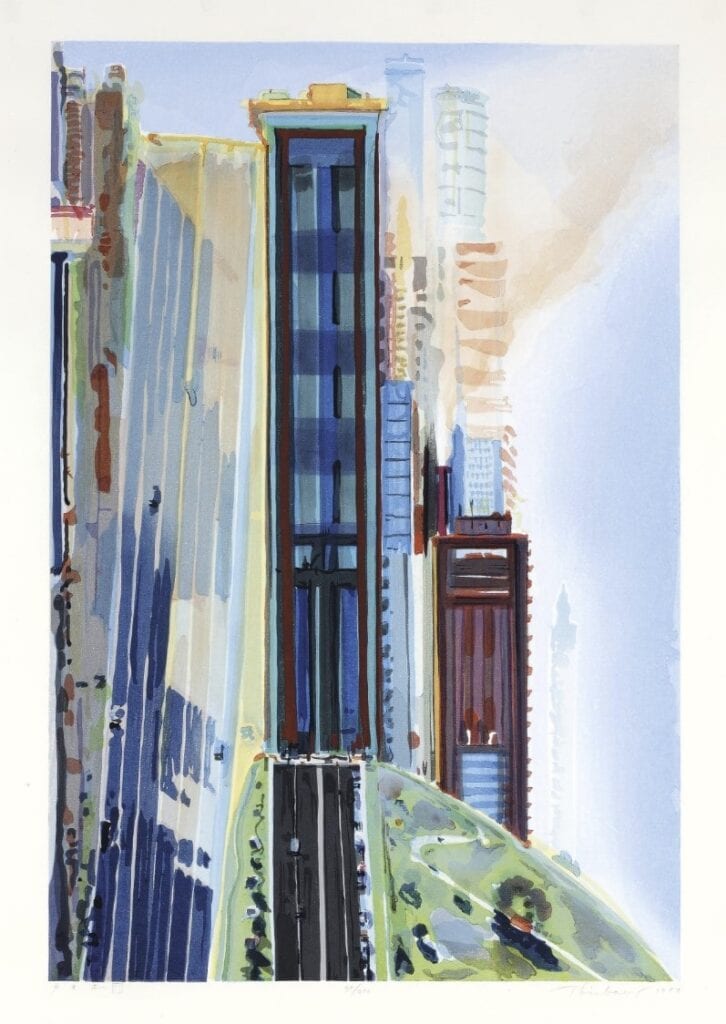
Figures
- Description: Portraits and figures, often portrayed in isolated, contemplative poses.
- Significance: Though less frequent than his still lifes and landscapes, Thiebaud’s figure paintings are characterized by their introspective mood and the careful study of light and shadow. They often convey a sense of stillness and introspection.
- Examples: "Girl with Ice Cream Cone" (1963), "Supine Woman" (1963), "Seated Man - Back View" (1964).
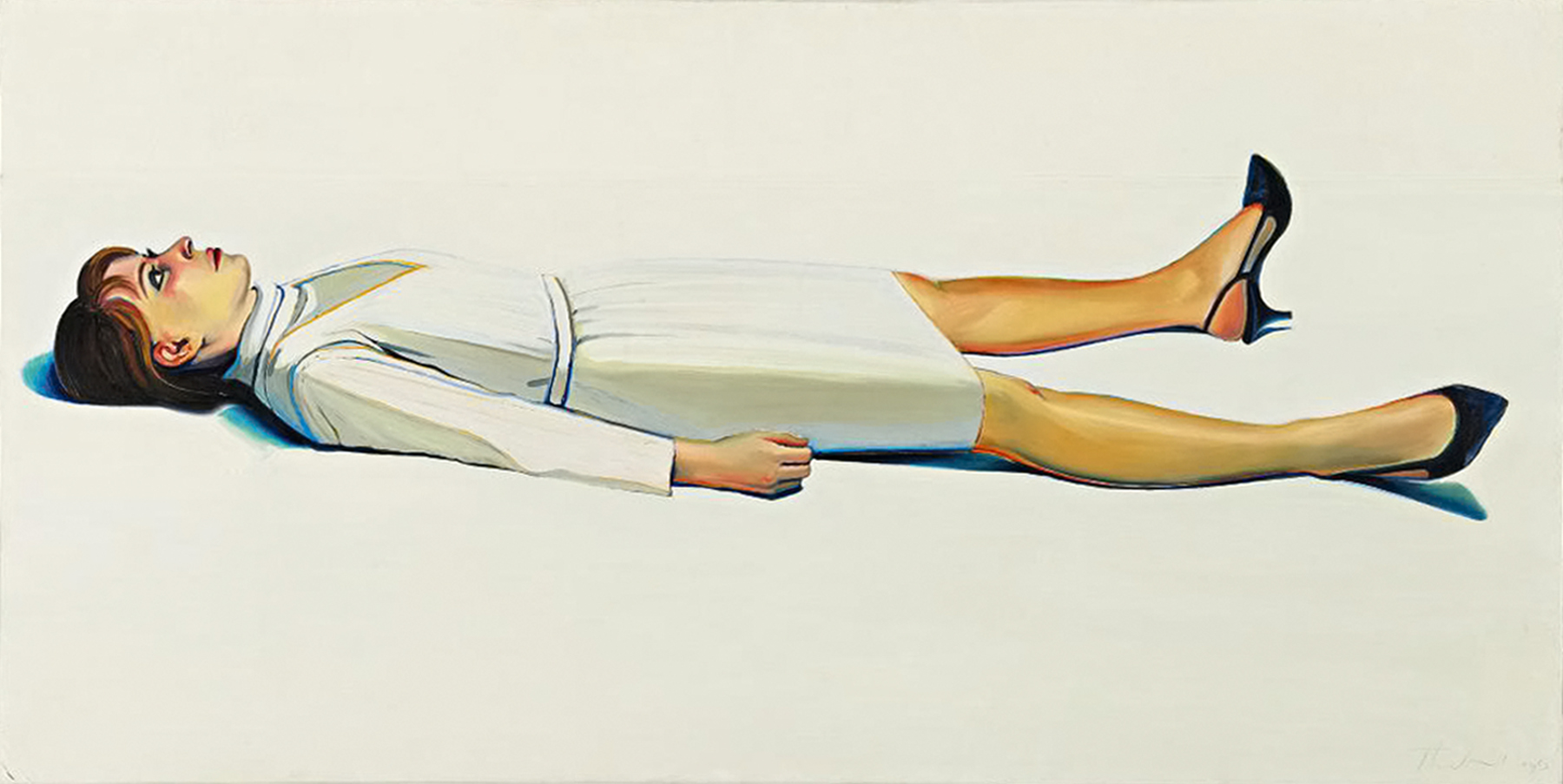
Clothing and Accessories
- Description: Paintings of articles of clothing and accessories, such as dresses, ties, and shoes.
- Significance: These works explore the textures, colors, and forms of everyday attire, often arranged in a straightforward yet visually appealing manner. Thiebaud’s attention to detail and his use of vibrant, saturated colors make these seemingly mundane objects captivating.
- Examples: "Row of Ties" (1969), "Yellow Dress" (1974), "Black Shoes" (1963).

Notable Wayne Thiebaud Cupcake Paintings
"Four Cupcakes" (1971)
- Description: This painting features four cupcakes arranged in a row, each rendered with Thiebaud's characteristic thick, impasto brushstrokes and vibrant colors.
- Auction Price: "Four Cupcakes" sold for $800,000 at Sotheby’s New York in November 2019.
"Cupcake Rows" (2003)
- Description: A depiction of multiple rows of cupcakes, showcasing Thiebaud's interest in repetition and pattern. The painting is notable for its joyful use of color and texture.
- Auction Price: "Cupcake Rows" fetched $1.6 million at Christie’s New York in May 2015.
"Six Cupcakes" (1977)
- Description: This work features six cupcakes displayed in two rows. The piece highlights Thiebaud’s ability to transform simple subjects into compelling compositions through the use of light, shadow, and color.
- Auction Price: "Six Cupcakes" was sold for $1.08 million at Sotheby’s New York in May 2018.
"Cupcakes and Donuts" (1995)
- Description: Combining two of Thiebaud’s favorite dessert motifs, this painting places cupcakes next to donuts, emphasizing their different textural qualities and inviting viewers to appreciate their form and color.
- Auction Price: "Cupcakes and Donuts" sold for $3.4 million at Christie’s New York in November 2013.
Notable Wayne Thiebaud Cake Paintings
"Cakes" (1963)
- Description: One of Thiebaud’s most famous works, "Cakes" depicts an array of cakes arranged in a row, each rendered with his characteristic thick, luscious brushstrokes and vibrant colors.
- Auction Price: While the specific auction price of "Cakes" is not readily available, it is housed in the National Gallery of Art in Washington, D.C., indicating its significant value and importance.
"Encased Cakes" (2010-2011)
- Description: This painting features a series of cakes displayed in a glass case, highlighting Thiebaud’s ability to elevate everyday subjects to the level of fine art through his unique style and use of color.
- Auction Price: "Encased Cakes" sold for $8.46 million at Sotheby's New York in July 2020.
"Cakes and Pies" (1996)
- Description: This work depicts a variety of cakes and pies arranged in an enticing display, showcasing Thiebaud’s talent for composition and texture.
- Auction Price: "Cakes and Pies" fetched $5.08 million at Christie’s New York in May 2019.
"Nine Jelly Cakes" (1964)
- Description: This painting portrays nine jelly cakes, emphasizing their form and color with Thiebaud’s signature impasto technique.
- Auction Price: "Nine Jelly Cakes" was sold for $1.7 million at Christie’s New York in May 2009.
"Bakery Counter" (1996)
- Description: A detailed and vibrant depiction of a bakery counter filled with cakes and pastries, illustrating Thiebaud’s fascination with the presentation and aesthetic of desserts.
- Auction Price: "Bakery Counter" sold for $4.5 million at Sotheby’s New York in November 2013.

Notable Wayne Thiebaud Gumball Machine Paintings
"Three Machines" (1963)
- Description: One of Thiebaud's most famous and iconic works, "Three Machines" depicts three gumball machines filled with brightly colored gumballs, rendered with Thiebaud's characteristic thick brushstrokes and vibrant palette.
- Auction Price: "Three Machines" sold for $19.1 million at Christie’s New York in November 2019, setting a record for Thiebaud’s work at the time.
"Gumball Machine" (1970)
- Description: This painting features a single gumball machine filled with multicolored gumballs, showcasing Thiebaud's skill in capturing the texture and shine of the glass and the candy.
- Auction Price: "Gumball Machine" fetched $6.3 million at Sotheby’s New York in May 2015.
"Gumball Machine #2" (1973)
- Description: This work depicts another single gumball machine, focusing on the vibrant colors and the intricate reflections on the glass surface.
- Auction Price: Although specific auction records for "Gumball Machine #2" are not readily available, similar works have sold in the multi-million-dollar range, reflecting their high value.
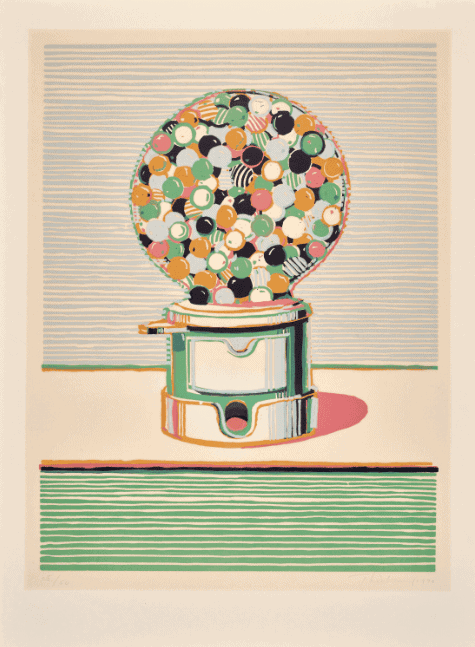
Notable Wayne Thiebaud Donut Paintings
"Boston Cremes" (1962)
- Description: This painting features a row of Boston cream donuts, each meticulously rendered with Thiebaud’s characteristic thick impasto and vibrant color palette.
- Auction Price: "Boston Cremes" sold for $1.7 million at Christie’s New York in November 2009.
"Chocolate Donuts" (1964)
- Description: A detailed depiction of chocolate donuts, showcasing Thiebaud’s ability to capture the texture and appeal of the frosting and dough.
- Auction Price: Although specific auction records for "Chocolate Donuts" are not readily available, similar works from this period have fetched prices in the range of $1 million to $3 million, reflecting their high value.
"Four Donuts" (1963)
- Description: This painting features four donuts arranged in a row, each rendered with Thiebaud's meticulous attention to detail and vibrant color use.
- Auction Price: "Four Donuts" fetched $2.8 million at Sotheby’s New York in November 2014.
"Donuts and Coffee" (1963)
- Description: A charming composition featuring donuts alongside a cup of coffee, highlighting Thiebaud’s interest in everyday items and their presentation.
- Auction Price: "Donuts and Coffee" sold for $1.2 million at Sotheby’s New York in May 2007.
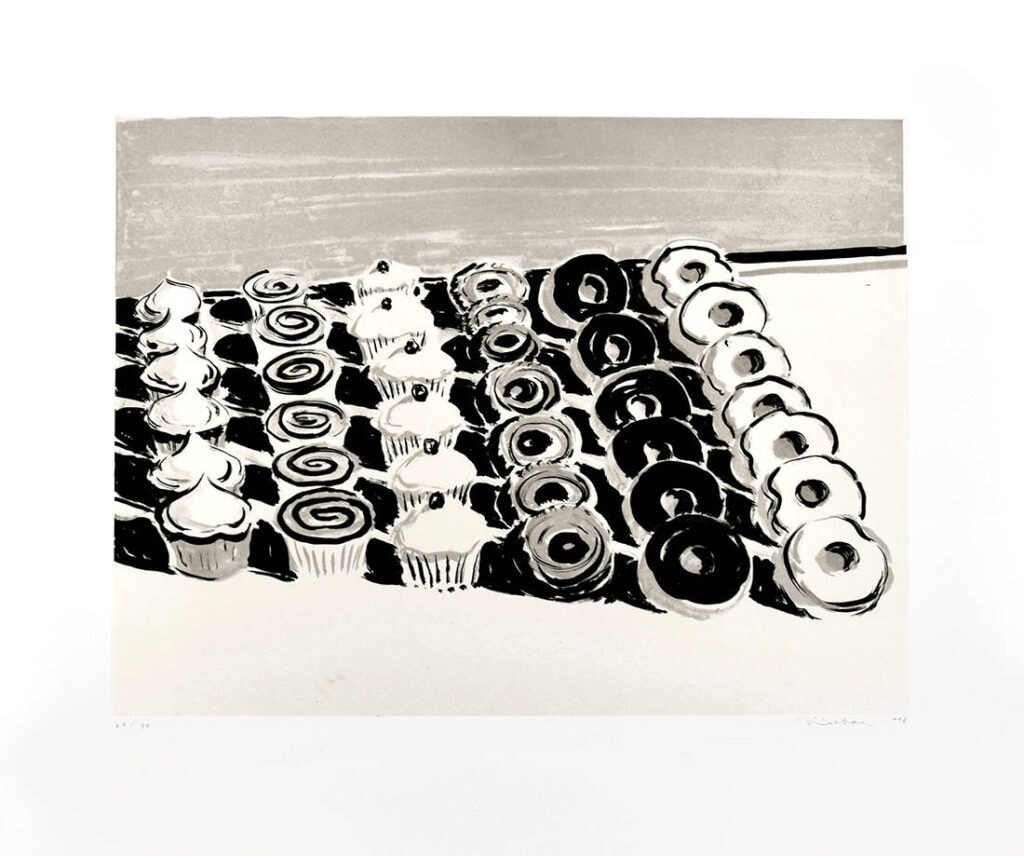
Notable Wayne Thiebaud Pie Paintings
"Pies, Pies, Pies" (1961)
- Description: This iconic painting features an array of pies, each meticulously rendered with Thiebaud’s characteristic thick impasto and vibrant colors.
- Auction Price: "Pies, Pies, Pies" sold for $3.8 million at Sotheby’s New York in May 2014.
"Blueberry Custard" (1961)
- Description: A detailed depiction of a blueberry custard pie, showcasing Thiebaud’s ability to capture the texture and appeal of the filling and crust.
- Auction Price: "Blueberry Custard" fetched $6.5 million at Sotheby’s New York in November 2013.
"Lemon Meringue Pie" (1964)
- Description: This painting features a single slice of lemon meringue pie, highlighting Thiebaud's meticulous attention to detail and vibrant color use.
- Auction Price: "Lemon Meringue Pie" sold for $4.4 million at Christie’s New York in November 2018.
"Nine Slices of Lemon Meringue Pie" (1968)
- Description: A composition featuring nine slices of lemon meringue pie, emphasizing Thiebaud’s interest in repetition and pattern.
- Auction Price: Although specific auction records for "Nine Slices of Lemon Meringue Pie" are not readily available, similar works from this period have fetched prices in the range of $1 million to $5 million.
